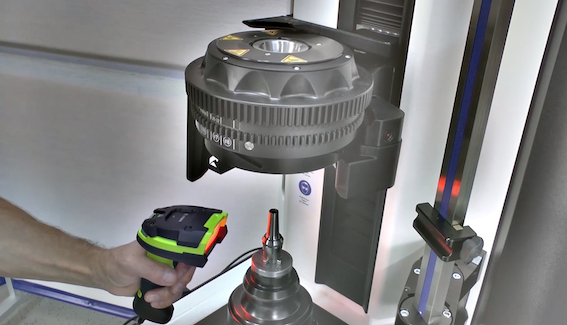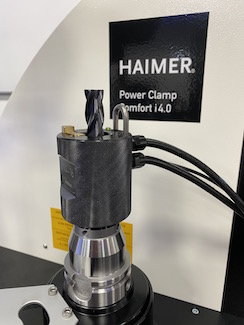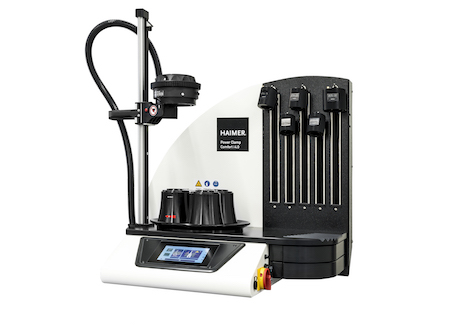Why You Should Take Another Look at Shrink-Fit Tooling
An expanding array of design and connectivity options is making this tooling method faster and easier. This cost/benefit analysis shows why shrink fit’s benefits extend beyond mold-making and 5-axis machining applications.
Posted: May 26, 2020
BY AUDREY THOMAS
For more than a century, metalworkers resigned themselves to running their milling machines at a certain rpm to avoid high runout and vibration caused by tool assembly unbalance. They could use one of two holders, each with its pros and cons: Weldon flat (side lock) toolholders have excellent tool security, but machining at high rpms compromises runout and balance. Collets have lower runout but not as much gripping torque, so machinists must lower rpms or decrease cutting depths to maintain tolerances and tool security.
Both limit a shop’s overall productivity. That’s why shrink-fit tooling was expanded on in the late 1990s by the German toolholding company Haimer.
First, A Brief Overview
Shrink fitting uses heat to clamp the cutting tool into the toolholder.
A machine using an induction heating device or hot air heats the outside diameter of a toolholder, expanding the inside bore, which starts slightly smaller than the cutting tool shank’s outer diameter. An adjustable stop disc ensures the toolholder isn’t overheated. A cooling sleeve containing circulating cold water is then placed over the assembly. As the assembly cools, the toolholder contracts around the entire cutting tool shank.
The result is an extremely tight, 360-degree friction fit with a tremendous amount of gripping torque, up to five times stronger than other friction-fit toolholder options. Total indicator readings (TIR) are around 0.00012-inch at three times the cutting tool diameter. Haimer, for example, guarantees less than 3 microns runout at 3xD with its shrink-fit chucks.
The entire process typically takes less than a minute: 3 seconds to 5 seconds to heat up and 30 seconds to 60 seconds to cool down. Some Haimer machines accommodate multiple toolholders simultaneously, effectively making tool change time 5 seconds per holder.
Shrink fit is considered one of the best toolholding methods for high-performance machining. Metal mold and die makers were the first to adopt the technology because they need a slim nose and long reach. However, today virtually any metal fabrication and metalworking processing facility may use shrink-fit tooling.
Shrink-Fit Cost/Benefit Analysis
Shrink-fit machines start at around $5,000. They also require additional power, adding an ongoing expense. While that may scare off some shops, the technology provides a quick return on investment by increasing overall process efficiency.
“The answer lies in the toolholder assembly’s performance benefits,” says Haimer USA President Brendt Holden. “Setup consistency is the best improvement. Because setup is the same from operator to operator, a shop can confidently predict tool life. Also, in most cases, removal rates increase because of better balance, lower runouts, and solid gripping torque.”
A shop would have to spend twice as much on high-precision collet, milling, or hydraulic toolholders to get the same benefits. Tooling up two machining centers with a shrink-fit machine and shrink-fit toolholders costs the same as tooling up two machines using traditional toolholding – and, once installed, a shop’s other machines can use the technology to improve other operations. In addition to providing tight tolerances, shrink-fit tooling increases metal removal rates, results in less runout, and speeds up tool changing.
“These three benefits greatly assist any shop’s production,” Holden says. He estimates a high-end shrink-fitting system pays for itself within six months.
Shrink-fit extensions also enhance flexibility. For example, when machining deep cavities, shrink-fit extensions can be placed into standard shrink-fit chucks to increase gage lengths with minimal runout.
A shrink-fit toolholder is a sealed system by design. Therefore, shrink fitting also eliminates the chance that contaminants will compromise runout accuracy by getting into the toolholder’s bore during machining.
Some machinists think shrink-fit tooling complicates setup, but the reality is the opposite. Shrink-fit holders are the fastest and most consistent way to clamp cutting tools. In 5 seconds to 10 seconds, the tool is changed in a process that’s done the exact same way from operator to operator.
“There are no variables in the assembly setup whether you’ve been setting up tools for two weeks or 20 years – the cutting tools go in and out the same every time,” Holden says. This leads to consistent setup, with translates to consistent part production and reliable tool life.
More Options Than Ever
Virtually every toolholder manufacturer offers shrink-fit toolholders. However, like any product category, some perform better than others.
It is important to ensure the holder has a rigid interface in the machine tool, based on a properly ground taper. Also, to get the good runout accuracy available with a properly produced shrink-fit holder, make sure the system holds a tight tolerance between the taper and bore.
Also, the standard shrink-fit toolholder design probably isn’t appropriate for every application. Unlike other manufacturers, Haimer expanded its product line according to geometry: Power Shrink for high rpms, Heavy-Duty Shrink for large cutting tools and deep cuts, Safe-Lock Shrink to further minimize the possibility of pullout, and Power Mini Shrink for very small tools. Applications range from heavy roughing to fine finishing and from slower-speed applications such as titanium roughing to high-speed applications such as structural aerospace, medical, die mold, and dental device/implant machining.
There are also many shrink-fit machines on the market. Haimer alone offers over 20 configurations from entry-level desktop models to automated systems.
“The most important thing is to confirm the machine is sophisticated enough to prevent overheating the toolholder,” says Holden. “All our models have this feature without slowing cycle time.”
In general, Haimer machines are also modular, which allows machinists to grow into the technology.
One of the company’s best-selling machines, the Power Clamp Preset NG, is a two-in-one hybrid that combines a tool-length presetter with a shrink-fit machine featuring an intelligent new generation (NG) coil. Stop discs are no longer required because the coil automatically adjusts to the toolholder’s length and diameter. “It’s used by customers with multispindle machines that must set up families of tools with exact gage lengths for each spindle,” says Holden.
From better runout accuracy to increased gripping torque, shrink-fit tooling lets machinists run at higher rpms, decrease setup times, and improve surface quality. Try it in your shop, and you’ll be impressed with the results.







